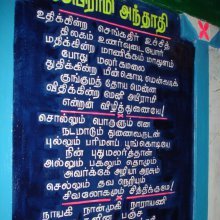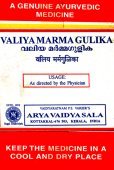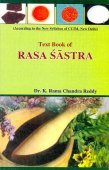Toya, Toyā: 26 definitions
Introduction:
Toya means something in Hinduism, Sanskrit, Buddhism, Pali, Marathi, Jainism, Prakrit, Hindi, biology. If you want to know the exact meaning, history, etymology or English translation of this term then check out the descriptions on this page. Add your comment or reference to a book if you want to contribute to this summary article.
Alternative spellings of this word include Toy.
Images (photo gallery)
In Hinduism
Purana and Itihasa (epic history)
Source: Wisdom Library: Varāha-purāṇaToyā (तोया).—Name of a river originating from Vindhya, a holy mountain (kulaparvata) in Bhārata, according to the Varāhapurāṇa chapter 85. There are settlements (janapada) where Āryas and Mlecchas dwell who drink water from these rivers.
Bhārata is a region south of Hemādri, once ruled over by Bharata (son of Ṛṣabha), whose ancestral lineage can be traced back to Svāyambhuva Manu, who was created by Brahmā, who was in turn created by Nārāyaṇa, the unknowable all-pervasive primordial being.
The Varāhapurāṇa is categorised as a Mahāpurāṇa, and was originally composed of 24,000 metrical verses, possibly originating from before the 10th century. It is composed of two parts and Sūta is the main narrator.
Source: archive.org: Shiva Purana - English TranslationToya (तोय) refers to “water” (part of austerities performed in the late winter season), according to the Śivapurāṇa 2.5.1 (“Description of Tripura—the three cities”).—Accordingly, as Sanatkumāra narrated to Vyāsa: “O great sage, when the Asura Tāraka was killed by Skanda, the son of Śiva, his three sons performed austerities. [...] In the late winter they stayed under water (toya-madhyaga) or wore wet dripping silken cloth or allowed themselves to be covered with dew drops. They were not at all vexed or distressed thereby. They gradually increased the severity of their austerities. Thus the three excellent sons of Tāraka performed penance with Brahmā as the object of their worship. [...]”.
Source: Cologne Digital Sanskrit Dictionaries: The Purana Index1a) Toyā (तोया).—A river from the Vindhyas.*
- * Brahmāṇḍa-purāṇa II. 16. 33; Matsya-purāṇa 114. 28; Vāyu-purāṇa 45. 103.
1b) A R. of the Śālmalam.*
- * Vāyu-purāṇa 49. 42.

The Purana (पुराण, purāṇas) refers to Sanskrit literature preserving ancient India’s vast cultural history, including historical legends, religious ceremonies, various arts and sciences. The eighteen mahapuranas total over 400,000 shlokas (metrical couplets) and date to at least several centuries BCE.
Ayurveda (science of life)
Kalpa (Formulas, Drug prescriptions and other Medicinal preparations)
Source: Shodhganga: Edition translation and critical study of yogasarasamgrahaToya (तोय) is another name for “Hrībera” and is dealt with in the 15th-century Yogasārasaṅgraha (Yogasara-saṅgraha) by Vāsudeva: an unpublished Keralite work representing an Ayurvedic compendium of medicinal recipes. The Yogasārasaṃgraha [mentioning toya] deals with entire recipes in the route of administration, and thus deals with the knowledge of pharmacy (bhaiṣajya-kalpanā) which is a branch of pharmacology (dravyaguṇa).
Veterinary Medicine (The study and treatment of Animals)
Source: Asian Agri-History: Paśu Āyurvēda (Veterinary Medicine) in GaruḍapurāṇaToya (तोय) refers to “water” and is used in the various Anupāna (“drink take”), according to sections on the treatment of Horses (Gajāyurveda or Aśvāyurveda) in the Garuḍapurāṇa.—The Anupāna i.e. the drink take along with or after medicine was important in treatment. Because it may help in carrying, absorption, assimilation and enhancing action of the drugs. Normally the selection of anupāna is done depends upon disease, doṣa etc.—[...] In diseases of the deranged and aggravated vāyu the medicine should be administered through the taila (oil), or in combination with śarkarā (sugar), ājya/ghṛita (ghee) or toya (water).
Toxicology (Study and Treatment of poison)
Source: Shodhganga: Kasyapa Samhita—Text on Visha ChikitsaToya (तोय) refers to “water” (used in the preparation of a recipe), according to the Kāśyapa Saṃhitā: an ancient Sanskrit text from the Pāñcarātra tradition dealing with both Tantra and Viṣacikitsā—an important topic from Āyurveda which deals with the study of Toxicology (Viṣavidyā or Sarpavidyā).—The antidote given by Kāśyapa for Darvīkara poison reads thus (Cf. verse VIII.6-7): The root of Aṅkola tree, salt, two palas or measures (roughly 96 grams) of the two types of Bṛhatī, Bṛhatī and Kaṇṭakārī belonging to Vidārādi-gaṇa are called dve bṛhatyau, kaṭutrayam, mustard seeds, kitchen soot, a paste of of all these in equal quantities prepared with water (toya), serves as a life-saving drug.

Āyurveda (आयुर्वेद, ayurveda) is a branch of Indian science dealing with medicine, herbalism, taxology, anatomy, surgery, alchemy and related topics. Traditional practice of Āyurveda in ancient India dates back to at least the first millenium BC. Literature is commonly written in Sanskrit using various poetic metres.
Jyotisha (astronomy and astrology)
Source: Wisdom Library: Brihat Samhita by VarahamihiraToya (तोय) refers to “water”, according to the Bṛhatsaṃhitā (chapter 5), an encyclopedic Sanskrit work written by Varāhamihira mainly focusing on the science of ancient Indian astronomy astronomy (Jyotiṣa).—Accordingly, “If the solar or lunar disc should be just dimmed by darkness all round which disappears immediately, the eclipse is technically known as Leha (licking): all creatures will be happy and the earth will be flooded with water [i.e., toya]. If a third, or a fourth, or one half of the disc should be eclipsed, it is technically known as Grasana (seizing with the mouth) grasa—partial eclipse: the wealth of prosperous princes will suffer diminution and prosperous countries will be afflicted with calamities”.

Jyotisha (ज्योतिष, jyotiṣa or jyotish) refers to ‘astronomy’ or “Vedic astrology” and represents the fifth of the six Vedangas (additional sciences to be studied along with the Vedas). Jyotisha concerns itself with the study and prediction of the movements of celestial bodies, in order to calculate the auspicious time for rituals and ceremonies.
Shaktism (Shakta philosophy)
Source: Google Books: ManthanabhairavatantramToya (तोय) or Toyatattva refers to the “water principle”, according to the Manthānabhairavatantra, a vast sprawling work that belongs to a corpus of Tantric texts concerned with the worship of the goddess Kubjikā.—Accordingly, “(Kubjikā) is the colour of (dark) blue collyrium. [...] The lotus, which is the eight-fold creation, should be imagined on the ghost. The Earth principle is in (the Wheel) of the Self-supported. One should think that Water [i.e., toya] is in (her) navel and Fire in the centre of the heart. One should imagine that Wind is in (her) throat and Space on (her) forehead. All (the elements) are located in these (places). Thousands of millions of Kulas are part of the Kula tradition. The teaching concerning (the goddess’s) body is hard to acquire even by the gods.”.

Shakta (शाक्त, śākta) or Shaktism (śāktism) represents a tradition of Hinduism where the Goddess (Devi) is revered and worshipped. Shakta literature includes a range of scriptures, including various Agamas and Tantras, although its roots may be traced back to the Vedas.
Yoga (school of philosophy)
Source: ORA: Amanaska (king of all yogas): A Critical Edition and Annotated Translation by Jason BirchToya (तोय) or Toyatattva refers to the “(elemental power of) water” and as one of the “five elemental powers”, represents one of the various signs and paranormal powers (siddhi) experienced by the Yoga practicioner, according to the Amanaska Yoga treatise (presented in the form of a dialogue between Īśvara and Vāmadeva).—The last fifty-two verses of the Amanaska’s first chapter describe a temporal sequence of psychosomatic signs and paranormal powers (siddhi) brought about by absorption (laya). In the Amanaska, The five elemental powers are, [e.g., water (toya-tattva)], [...].

Yoga is originally considered a branch of Hindu philosophy (astika), but both ancient and modern Yoga combine the physical, mental and spiritual. Yoga teaches various physical techniques also known as āsanas (postures), used for various purposes (eg., meditation, contemplation, relaxation).
Biology (plants and animals)
Source: Google Books: CRC World Dictionary (Regional names)1) Toya in India is the name of a plant defined with Ficus racemosa in various botanical sources. This page contains potential references in Ayurveda, modern medicine, and other folk traditions or local practices It has the synonym Covellia glomerata Miq. (among others).
2) Toya is also identified with Pavonia odorata It has the synonym Hibiscus oligosandrus Buch-Ham. (etc.).
Example references for further research on medicinal uses or toxicity (see latin names for full list):
· Bulletin of the Torrey Botanical Club (1946)
· Blumea (1966)
· London Journal of Botany (1848)
· Species Plantarum. (1822)
· Flora de Filipinas (1837)
· Monadelphiae Classis Dissertationes Decem (1786)
If you are looking for specific details regarding Toya, for example extract dosage, health benefits, side effects, pregnancy safety, chemical composition, diet and recipes, have a look at these references.

This sections includes definitions from the five kingdoms of living things: Animals, Plants, Fungi, Protists and Monera. It will include both the official binomial nomenclature (scientific names usually in Latin) as well as regional spellings and variants.
Languages of India and abroad
Pali-English dictionary
Source: BuddhaSasana: Concise Pali-English Dictionarytoya : (nt.) water.
Source: Sutta: The Pali Text Society's Pali-English DictionaryToya, (nt.) (Vedic toya from *tāǔ to melt away; Lat. tabeo, tabes (consumption); Ags. pāwan=E. dew, Oir. tām= tabes; also Gr. tήkw, etc. ) water (poetical for udaka); only in simile: puṇḍarīkaṃ (or padumaṃ) toyena na upalippati A. II, 39=Sn. 547; Sn. 71=213; Th. 1, 700; Nd2 287 (t. vuccati udakaṃ);— Bdhd 67, 93. (Page 307)

Pali is the language of the Tipiṭaka, which is the sacred canon of Theravāda Buddhism and contains much of the Buddha’s speech. Closeley related to Sanskrit, both languages are used interchangeably between religions.
Marathi-English dictionary
Source: DDSA: The Molesworth Marathi and English Dictionarytōya (तोय).—n S Water. Ex. phaḷa tōya varjūna samasta || nirāhāra baisalā raghunātha ||.
--- OR ---
tōya (तोय).—f (Or tōī) Gold or silver lace.
Source: DDSA: The Aryabhusan school dictionary, Marathi-Englishtōya (तोय).—n Water. f Gold or silver lace.
Marathi is an Indo-European language having over 70 million native speakers people in (predominantly) Maharashtra India. Marathi, like many other Indo-Aryan languages, evolved from early forms of Prakrit, which itself is a subset of Sanskrit, one of the most ancient languages of the world.
Sanskrit dictionary
Source: DDSA: The practical Sanskrit-English dictionaryToya (तोय).—
1) Water; Ś.7.12.
2) The constellation पूर्वाषाढा (pūrvāṣāḍhā) or its regent.
Derivable forms: toyam (तोयम्).
Source: Cologne Digital Sanskrit Dictionaries: Shabda-Sagara Sanskrit-English DictionaryToya (तोय).—n.
(-yaṃ) Water. E. tu to surround, Unadi affix koya or tāya to nourish, ac affix, and ā changed irregularly to o or tu + vic tave pūrttyai yāti yā + ka .
Source: Cologne Digital Sanskrit Dictionaries: Benfey Sanskrit-English DictionaryToya (तोय).—n. (perhaps from vb. tu), Water, [Mānavadharmaśāstra] 8, 409; with kṛ, To pour water in honour of a deceased, Mahābhārata 18, 32.
Source: Cologne Digital Sanskrit Dictionaries: Cappeller Sanskrit-English DictionaryToya (तोय).—[neuter] water (p. vant†); [accusative] [with] kṛ make a libation of water.
Source: Cologne Digital Sanskrit Dictionaries: Monier-Williams Sanskrit-English DictionaryToya (तोय):—n. (ifc. f(ā). ) water, [Naighaṇṭuka, commented on by Yāska i, 12; Manu-smṛti v, viii f.; Mahābhārata] etc. (yaṃ-√kṛ with [genitive case], ‘to make offerings of water to the dead’, [xviii, 32]; f(ā). Name of a river in Śālmala-dvīpa, [Viṣṇu-purāṇa ii, 4, 28]; of another in India).
Source: Cologne Digital Sanskrit Dictionaries: Yates Sanskrit-English DictionaryToya (तोय):—(yaṃ) 1. n. Water.
Source: DDSA: Paia-sadda-mahannavo; a comprehensive Prakrit Hindi dictionary (S)Toya (तोय) in the Sanskrit language is related to the Prakrit word: Toya.
[Sanskrit to German]
Sanskrit, also spelled संस्कृतम् (saṃskṛtam), is an ancient language of India commonly seen as the grandmother of the Indo-European language family (even English!). Closely allied with Prakrit and Pali, Sanskrit is more exhaustive in both grammar and terms and has the most extensive collection of literature in the world, greatly surpassing its sister-languages Greek and Latin.
Hindi dictionary
Source: DDSA: A practical Hindi-English dictionaryToya (तोय) [Also spelled toy]:—(nm) water.
...
Prakrit-English dictionary
Source: DDSA: Paia-sadda-mahannavo; a comprehensive Prakrit Hindi dictionary1) Toya (तोय) in the Prakrit language is related to the Sanskrit word: Toya.
2) Toya (तोय) also relates to the Sanskrit word: Toda.
Prakrit is an ancient language closely associated with both Pali and Sanskrit. Jain literature is often composed in this language or sub-dialects, such as the Agamas and their commentaries which are written in Ardhamagadhi and Maharashtri Prakrit. The earliest extant texts can be dated to as early as the 4th century BCE although core portions might be older.
Kannada-English dictionary
Source: Alar: Kannada-English corpusTōya (ತೋಯ):—[noun] a dish made of pulses and sometimes with vegetables.
--- OR ---
Tōya (ತೋಯ):—
1) [noun] water.
2) [noun] (pros.) a syllabic feet with one short syllable followed by two long syllables.
Kannada is a Dravidian language (as opposed to the Indo-European language family) mainly spoken in the southwestern region of India.
See also (Relevant definitions)
Starts with (+72): Toya-hina, Toyabhaya, Toyabindu, Toyacam, Toyacara, Toyachara, Toyada, Toyadana, Toyadatyaya, Toyadhara, Toyadhi, Toyadhipriya, Toyadhivasini, Toyadimba, Toyadimbha, Toyadivasini, Toyadri, Toyadrikshetra, Toyagarbha, Toyagni.
Ends with (+35): Agastoya, Antartoya, Antastoya, Asvadyatoya, Bhuritoya, Chattoya, Contoya, Danatoya, Gaddatoya, Gamgatoya, Gandhatoya, Gardatoya, Ghanatoya, Gharmatoya, Haritoya, Indratoya, Karakatoya, Karatoya, Kashayatoya, Kattoya.
Full-text (+157): Toyadhara, Toyada, Toyakama, Sadatoya, Toyanidhi, Toyavela, Toyashuktika, Toyadhi, Toyam, Toyakricchra, Toyacara, Karatoya, Toyasucaka, Toyamuc, Toyapippali, Toyaprashtha, Toyadhivasini, Toyamaya, Toyagni, Kattoya.
Relevant text
Search found 29 books and stories containing Toya, Toyā, Tōya; (plurals include: Toyas, Toyās, Tōyas). You can also click to the full overview containing English textual excerpts. Below are direct links for the most relevant articles:
Shrimad Bhagavad-gita (by Narayana Gosvami)
Verse 9.26 < [Chapter 9 - Rāja-guhya-yoga (Yoga through the most Confidential Knowledge)]
Puranic encyclopaedia (by Vettam Mani)
Sushruta Samhita, Volume 6: Uttara-tantra (by Kaviraj Kunja Lal Bhishagratna)
Chapter X - Treatment of Pittaja Ophthalmia < [Canto I - Shalakya-tantra (ears, eyes, nose, mouth and throat)]
Atithi or Guest Reception (study) (by Sarika. P.)
Part 10 - References to Hospitality in Uttararāmacarita < [Chapter 4 - Atithi-saparyā in Classical Sanskrit Literature]
The Matsya Purana (critical study) (by Kushal Kalita)
Part 2 - Rivers and Mountains of Bhāratavarṣa < [Chapter 8 - Geographical data in the Matsyapurāṇa]
Rivers in Ancient India (study) (by Archana Sarma)
2. The rivers in the Purāṇic Literature < [Chapter 5 - Rivers in the Purāṇic Literature]
10. Various other rivers in the Purāṇas < [Chapter 5 - Rivers in the Purāṇic Literature]
Related products


